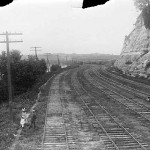Kaposia
Kaposia (English spelling) refers to a group of people more than a place, but is often described as a village below Indian Mounds Park in St. Paul.
The Kaposia people were known, even among the Dakota, as people who moved their home often. Moving back and forth from one bank of the Mississippi to another, Kaposia remained one of the closest villages to Fort Snelling. In the 1800’s, painter and Army captain Seth Eastman captured everyday Dakota life on canvas, giving many people their only glimpse of traditional Dakota culture, and many of his paintings recorded life in Kaposia. Because he was an outsider, his impression of what he was painting is not always reliable, and he recorded burial practices and other ceremonial activities that Dakota people considered highly private. Those images are not available on this site, but are often available on the web and in books.
Generations of leaders named Taoyateduta led the Kaposia villages. One of these leaders, called Le Petite Corbeau by the French, signed the 1805 treaty with Zebulon Pike. His grandson, called Little Crow, was an important participant in the Dakota War of 1862.
Bruce Vento Sanctuary in St. Paul is located near one site of a Kaposia village. Mounds Park is above Kaposia village sites. To underline the fluidity of these villages and the less rigid definitions of place of traditional Dakota people, we are including media on sites in the ‘Kaposia area.’ An Ojibwe youth producer tells us what it means to learn about Mounds Park and Tipi Wakan and other traditional Dakota sites near Kaposia village sites.







